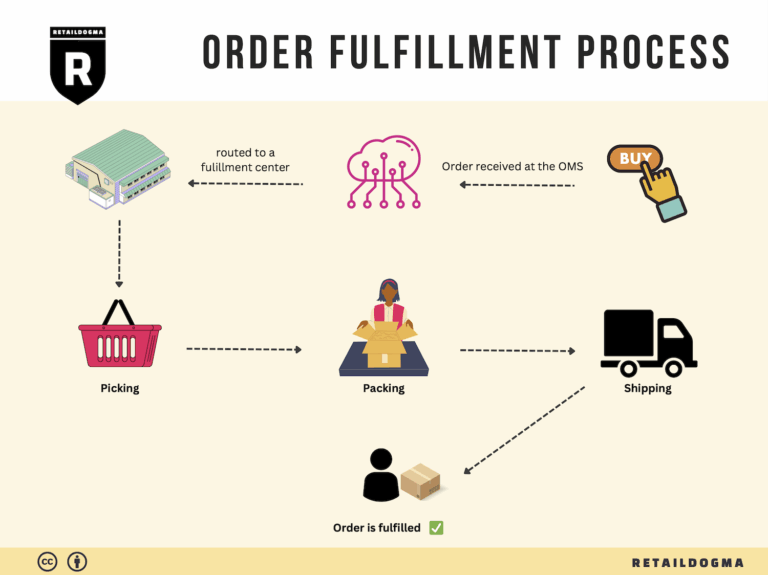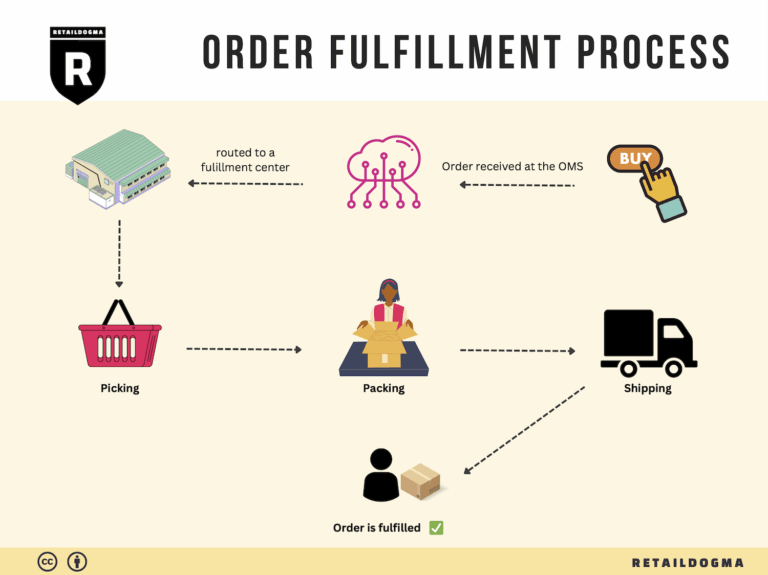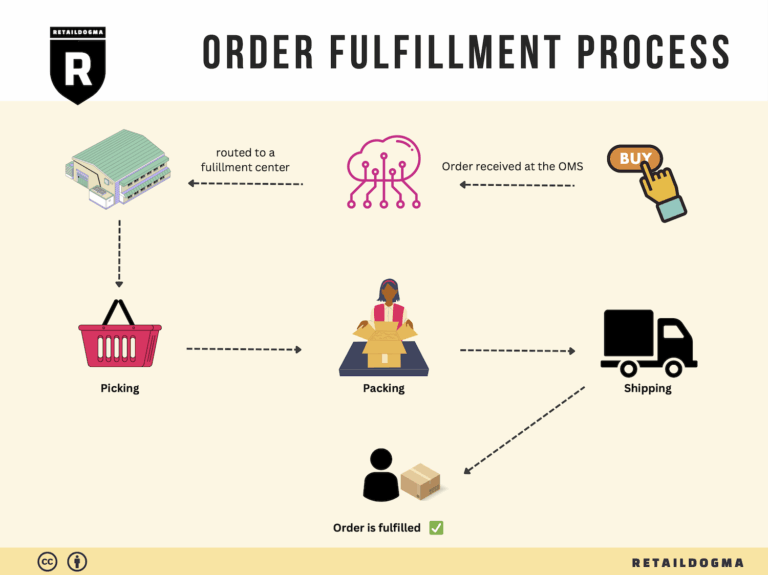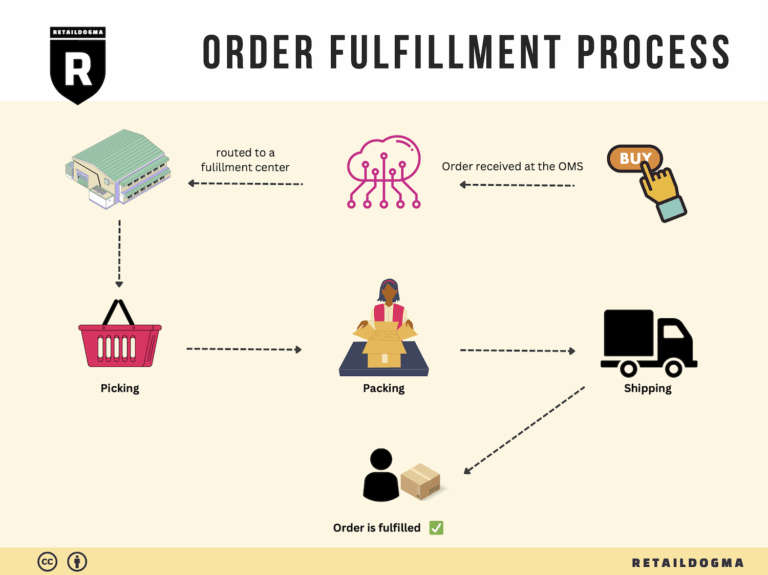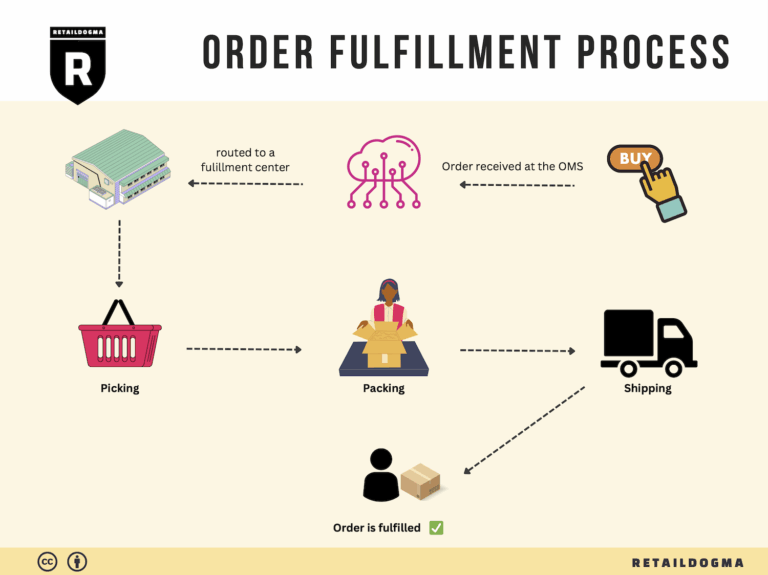Ecommerce Fulfillment Services: The Ultimate Guide (2025)
What is E-commerce Fulfillment? An Introduction for Growing Businesses
The Overwhelming Nature of Order Fulfillment
For many growing e-commerce businesses, the thrill of increasing sales can quickly turn into a daunting challenge as order fulfillment becomes overwhelming. Packing, shipping, and managing returns can consume valuable time and resources, often diverting attention from more strategic aspects of the business. As you scale, it’s crucial to streamline these processes to maintain customer satisfaction and operational efficiency.
Understanding E-commerce Fulfillment
At its core, e-commerce fulfillment is the comprehensive process of getting a product into the hands of the customer. This includes everything from inventory management and order processing to packing and shipping. As your business grows, understanding the various fulfillment models available can significantly impact your operational success. Whether you consider utilizing a third-party logistics provider (3PL), leveraging Fulfillment by Amazon (FBA), or managing fulfillment in-house, each option presents unique advantages and challenges.
Core Services of Fulfillment
In this guide, we will delve into the essential services associated with e-commerce fulfillment. We’ll explore:
- Inventory Management: How to effectively track and manage stock levels to avoid overstocking or stockouts.
- Order Processing: The importance of efficient order processing systems to ensure timely dispatch.
- Shipping Solutions: Evaluating different shipping carriers and methods to optimize delivery times and costs.
- Returns Management: Strategies for handling returns smoothly to enhance customer satisfaction and loyalty.
Choosing the Right Fulfillment Partner
Selecting the right fulfillment partner is a critical decision that can influence your business’s growth trajectory. In this guide, we will provide practical criteria for assessing potential partners, including their technology capabilities, service level agreements, and scalability options. Understanding what to look for will empower you to make informed decisions that align with your business goals.
Pricing Considerations
Cost is always a significant factor in logistics decisions. This guide will cover pricing structures commonly associated with fulfillment services, helping you understand the various components that contribute to overall costs. By comprehending these elements, you can better budget and negotiate with potential partners.
Empowering Your Business Decisions
Ultimately, this guide aims to empower e-commerce business owners and operations managers to make smart, strategic decisions regarding their logistics and fulfillment processes. By grasping the nuances of e-commerce fulfillment, you can enhance your operational efficiency, improve customer satisfaction, and position your business for sustainable growth.
What You’ll Learn In This Guide
- What is E-commerce Fulfillment? An Introduction for Growing Businesses
- The Order Fulfillment Process: From ‘Buy’ Button to Customer’s Door
- Comparing Fulfillment Models: In-House vs. 3PL vs. Dropshipping
- A Deep Dive into Amazon FBA: Pros, Cons, and Who It’s For
- Core Services Offered by Fulfillment Centers
- How to Choose a Fulfillment Partner: A 6-Point Checklist
- Understanding Fulfillment Pricing: A Breakdown of Common Fees
- Frequently Asked Questions (FAQs) about Fulfillment
- Conclusion: Is Outsourcing Fulfillment the Right Move for Your Business?
- Important Disclaimer
The Order Fulfillment Process: From ‘Buy’ Button to Customer’s Door
1. Receiving Inventory
The first step in the order fulfillment process is receiving inventory. This involves accepting products from suppliers and ensuring they are accounted for accurately. During this stage, each item is checked against purchase orders to confirm that the correct quantities and items have been delivered. Key terms associated with this step include SKU (Stock Keeping Unit), which uniquely identifies each product, allowing for efficient tracking and management.
Receiving inventory is crucial for maintaining accurate stock levels and ensuring that your warehouse is equipped to fulfill customer orders. If discrepancies occur during this process—such as damaged goods or missing items—it can lead to stockouts, which can frustrate customers and ultimately result in lost sales. A well-documented receiving process also aids in maintaining supplier relationships and helps in future inventory planning.
2. Warehouse Storage
Once inventory is received, the next step is warehouse storage. This involves organizing products within the warehouse in a manner that maximizes efficiency and accessibility. Items are placed in designated locations based on various factors, such as size, demand, and category. A key term here is bin location, which refers to the specific storage area assigned to each SKU.
Efficient warehouse storage is essential for speeding up the picking process later on. If products are stored haphazardly, it can lead to increased time spent locating items, which can delay order fulfillment. Additionally, proper storage practices reduce the risk of damage to products and enhance the overall organization of your inventory. A well-structured storage system not only facilitates quick access but also supports better inventory management, helping you keep track of stock levels and turnover rates.
3. Order Picking
Order picking is the process of selecting items from the warehouse to fulfill a customer order. This step is often guided by a pick list, which is a document that outlines the items and quantities needed for each order. The pick list is generated from the order management system, which consolidates all orders and provides the necessary information to warehouse staff.
This step is critical because the accuracy of order picking directly impacts customer satisfaction. Errors in picking can lead to incorrect shipments, prompting returns and exchanges that can strain resources and harm your brand’s reputation. Efficient order picking practices, such as batch picking (where multiple orders are picked simultaneously) or zone picking (where specific areas of the warehouse are assigned to individual pickers), can significantly enhance productivity and reduce fulfillment time.
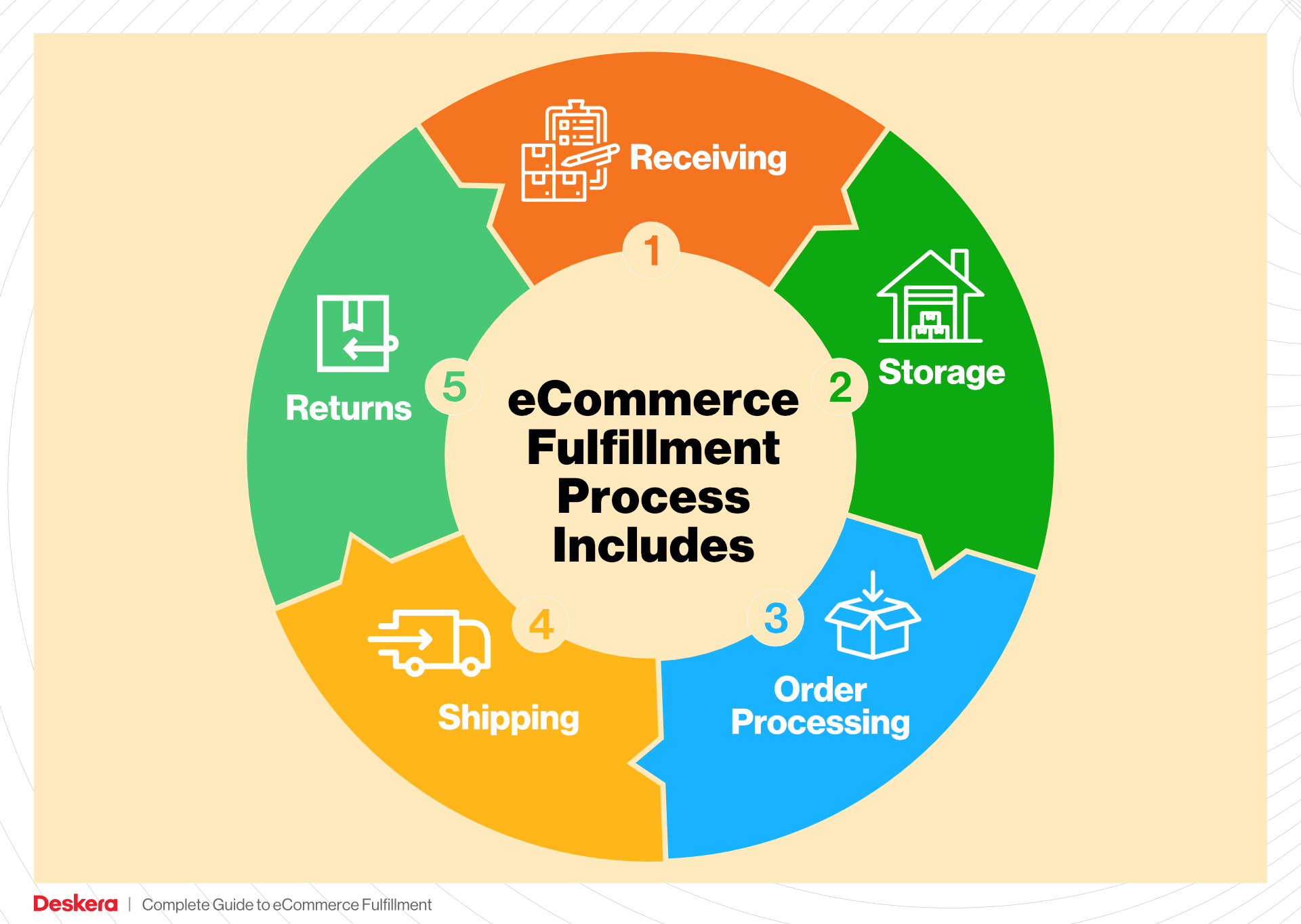
4. Order Packing
After the items have been picked, they move to the order packing stage. This involves securely packing the products for shipment to ensure they arrive at the customer’s location in good condition. Key terms associated with this step include packaging materials, which can range from boxes and padded envelopes to bubble wrap and tape.
Packing is a vital step in the fulfillment process because it protects the products from damage during transit. Additionally, well-packed orders enhance the unboxing experience for customers, which can lead to positive reviews and repeat business. Businesses should also consider implementing packing slips, which are documents included in the shipment that list the items in the package, providing clarity and reassurance to customers about what they can expect.
5. Shipping & Delivery
The final step in the order fulfillment process is shipping and delivery. This involves selecting a carrier, preparing shipping labels, and arranging for the transportation of the packed orders to the customer’s address. A key term in this phase is shipping method, which can include options like standard, expedited, or same-day delivery.
Shipping and delivery are crucial for meeting customer expectations and ensuring satisfaction. The speed and reliability of shipping can significantly influence a customer’s overall experience with your brand. Offering multiple shipping options can cater to different customer preferences, while tracking systems allow customers to monitor their order’s journey. Additionally, maintaining good relationships with carriers can lead to better rates and improved service, further enhancing your fulfillment capabilities.
In conclusion, understanding and optimizing each step of the order fulfillment process—from receiving inventory to shipping—can significantly enhance operational efficiency and customer satisfaction. As e-commerce continues to grow, focusing on these key processes will ensure your business can scale effectively and maintain a competitive edge in the marketplace.
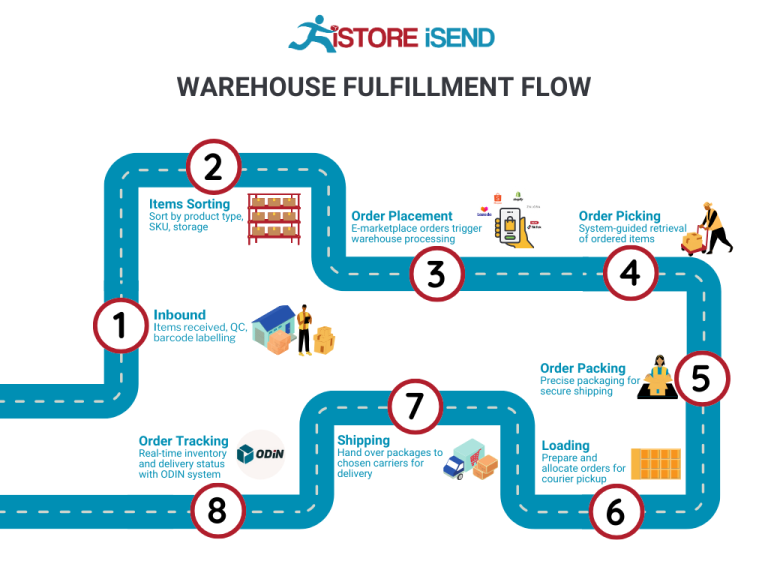
Comparing Fulfillment Models: In-House vs. 3PL vs. Dropshipping
Fulfillment Model Comparison
| Model | Who Handles Inventory | Best For (Business Stage) | Key Advantage | Key Disadvantage |
|---|---|---|---|---|
| In-House Fulfillment | The business itself | Startups to Established | Full control over inventory and processes | High overhead costs and resource demands |
| Third-Party Logistics (3PL) | A third-party provider | Growing to Mid-Sized | Scalability and reduced operational burden | Less control over inventory and processes |
| Dropshipping | Suppliers or manufacturers | Startups and Small Businesses | Low upfront costs and easy to start | Lower profit margins and potential stock issues |
In-House Fulfillment
In-house fulfillment refers to a model where a business manages all aspects of its inventory, order processing, and shipping internally. This model is particularly suitable for startups and established businesses that want complete control over their logistics operations. By handling fulfillment in-house, businesses can customize their processes to align with their brand values and customer service standards. This control enables them to implement tailored packaging, faster shipping options, and direct communication with customers regarding their orders.
However, this model comes with significant challenges. Maintaining an in-house fulfillment operation can lead to high overhead costs, including warehousing expenses, staffing, and technology investments. As the business scales, these costs can escalate quickly, potentially impacting profitability. Additionally, managing inventory effectively requires strong operational expertise and can become increasingly complex as product lines expand and customer demand fluctuates.
Third-Party Logistics (3PL)
Third-party logistics (3PL) involves outsourcing the fulfillment process to a specialized logistics provider. This model is ideal for businesses that are growing and need to scale their operations without incurring the high costs associated with managing fulfillment in-house. 3PL providers offer a range of services, including warehousing, inventory management, order processing, and shipping, allowing businesses to focus on their core competencies like marketing and product development.
The key advantage of using a 3PL is the scalability it provides. As order volumes increase, businesses can easily adjust their logistics needs without the burden of investing in additional infrastructure. Moreover, 3PL providers often have established relationships with shipping carriers, which can lead to lower shipping rates and improved delivery times. However, outsourcing fulfillment means relinquishing some control over the logistics process, which can lead to challenges in maintaining quality and consistency in customer experience. Businesses must carefully select 3PL partners to ensure alignment with their operational goals.
Dropshipping
Dropshipping is a fulfillment model where the retailer does not keep products in stock but instead relies on suppliers to ship products directly to customers. This model is particularly attractive for startups and small businesses that wish to minimize upfront costs and financial risks associated with inventory. With dropshipping, entrepreneurs can quickly launch an e-commerce store without the need for significant investments in inventory or warehousing.
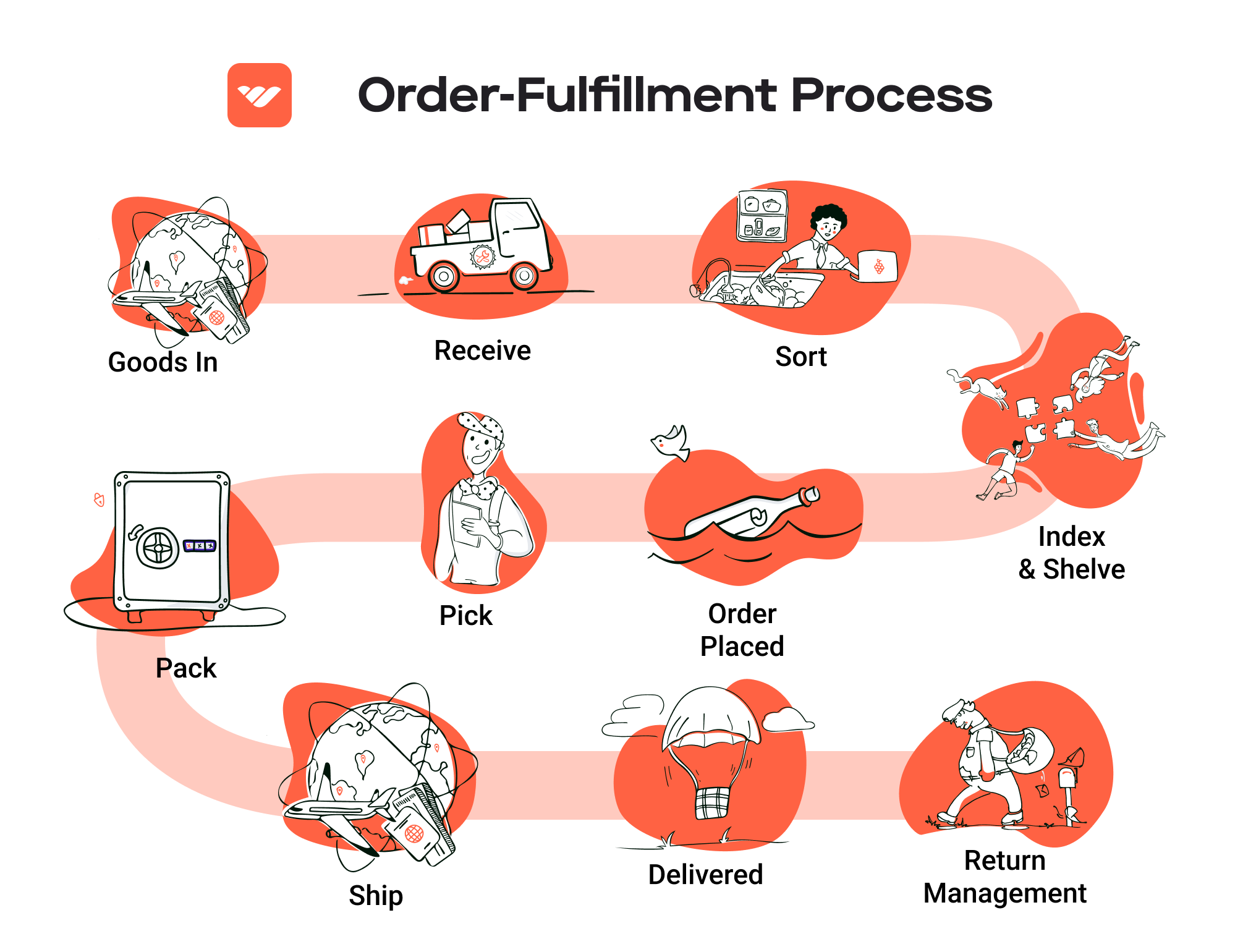
The primary advantage of dropshipping is the low barrier to entry. Entrepreneurs can start selling products without having to purchase inventory upfront, which allows for a broader range of product offerings. Additionally, it provides flexibility in testing new products without financial commitment. However, dropshipping comes with its disadvantages. Profit margins can be lower compared to other fulfillment methods due to the retailer’s reliance on suppliers. Furthermore, issues such as stock shortages or shipping delays can arise, impacting customer satisfaction and brand reputation. Businesses must establish strong relationships with reliable suppliers to mitigate these risks.
Conclusion
Choosing the right fulfillment model is crucial for e-commerce businesses looking to scale effectively. Each model—In-House Fulfillment, 3PL, and Dropshipping—has its unique advantages and challenges. Understanding these differences allows business owners and operations managers to align their fulfillment strategy with their overall business goals, ensuring they can meet customer expectations while managing costs and operational efficiency. Ultimately, the decision should be based on the specific needs of the business, its growth trajectory, and its capacity to manage logistics effectively.
A Deep Dive into Amazon FBA: Pros, Cons, and Who It’s For
Understanding Fulfillment by Amazon (FBA)
Fulfillment by Amazon (FBA) is a service provided by Amazon that allows businesses to store their products in Amazon’s fulfillment centers. Amazon takes care of storage, packaging, and shipping of products directly to customers. This service is particularly beneficial for e-commerce businesses looking to scale their operations without the complexities of managing logistics themselves.
When a customer places an order for a product fulfilled by FBA, Amazon handles the entire fulfillment process. This includes picking the product from the warehouse, packing it, and shipping it to the customer. Additionally, Amazon manages customer service and returns for these orders.
How FBA Works
-
Setup and Inventory: Sellers create an Amazon seller account and set up FBA by listing their products for sale. They then ship their inventory to Amazon’s fulfillment centers.
-
Storage: Once the products arrive at the fulfillment center, Amazon stores them until they are sold. Sellers can monitor their inventory levels through their Amazon seller account dashboard.
-
Order Fulfillment: When a customer places an order, Amazon’s systems automatically select the nearest fulfillment center to expedite shipping. The product is picked, packed, and shipped directly to the customer.
-
Customer Service and Returns: Amazon handles all customer inquiries and returns for FBA orders, allowing sellers to focus on other aspects of their business.
Pros of Using FBA
Prime Eligibility
Products fulfilled through FBA automatically qualify for Amazon Prime, making them eligible for free two-day shipping. This can significantly increase sales, as Prime members often prefer to buy products that come with fast, free shipping.
Customer Trust
When customers see the “Fulfilled by Amazon” label, it often increases their trust in the seller. Amazon’s reputation for reliable shipping and customer service can lead to higher conversion rates.
Multi-Channel Fulfillment
FBA is not limited to Amazon sales. Sellers can use FBA to fulfill orders from their own websites or other online marketplaces, allowing for a streamlined logistics process across multiple sales channels.
Scalability
As businesses grow, FBA can handle increased order volumes without the need for sellers to invest in additional warehouse space or staffing. Amazon’s logistics network allows businesses to scale efficiently.
Simplified Returns
Amazon manages returns for FBA orders, which can be a complex and time-consuming process for sellers. This service provides a smoother experience for customers, which can enhance brand loyalty.
Cons of Using FBA
High Fees
FBA comes with various fees, including storage fees for products stored in fulfillment centers and fulfillment fees for each unit sold. These costs can add up, especially for products that have a slower turnover rate.
Strict Inventory Rules
Amazon has strict guidelines regarding inventory management. Sellers must ensure their products comply with Amazon’s policies, which can be challenging for businesses with diverse product lines.
Commingling Risks
When sellers use FBA, their inventory may be commingled with that of other sellers. This means that customers could receive a product from a different seller, which can lead to issues with product quality and authenticity.
Limited Control
Using FBA means relinquishing some control over the fulfillment process. Sellers must rely on Amazon’s systems and processes, which can be a concern if issues arise.
Inventory Management Challenges
Managing inventory levels can be complex when using FBA. Sellers must balance the costs of storage and the risk of running out of stock, which can affect sales.
Who is FBA Best For?
Fulfillment by Amazon is ideally suited for e-commerce businesses that:
-
Have High Sales Volumes: Businesses with a steady flow of orders can benefit from FBA’s logistics efficiency, making it a suitable option for those scaling rapidly.
-
Sell in High Demand Niches: Sellers offering popular or trending products can take advantage of Prime eligibility and customer trust to maximize sales.
-
Desire to Expand Reach: Businesses looking to sell across multiple platforms can benefit from the multi-channel fulfillment aspect of FBA, allowing them to reach a broader audience.
-
Want to Focus on Core Business Functions: Companies that prefer to focus on product development, marketing, and customer engagement rather than logistics may find FBA to be a valuable solution.
-
Can Manage Costs: Sellers who can effectively manage their pricing strategies to absorb FBA fees while maintaining profitability will find FBA advantageous.
In conclusion, FBA can be a powerful tool for e-commerce businesses aiming to streamline their operations and enhance customer satisfaction. However, it is essential for sellers to carefully weigh the pros and cons and assess their specific business needs before diving into the FBA model.
Core Services Offered by Fulfillment Centers
Inventory Management & Warehousing
Inventory management and warehousing are foundational services provided by fulfillment centers that enable e-commerce businesses to maintain optimal stock levels and efficiently manage their product storage. This service encompasses the systematic tracking of inventory, from receiving goods from suppliers to storing them in designated warehouse locations.
Benefits:
-
Real-Time Visibility: Advanced inventory management systems allow businesses to monitor stock levels in real time. This visibility helps prevent stockouts and overstock situations, which can lead to lost sales or increased holding costs.
-
Reduced Storage Costs: Fulfillment centers typically operate on a larger scale, allowing them to negotiate better rates for warehousing space. This results in lower storage costs for e-commerce businesses that can leverage these economies of scale.
-
Efficient Space Utilization: Fulfillment centers are designed to maximize storage efficiency, utilizing vertical space and implementing strategic shelving. This means e-commerce businesses can store more products in less space, optimizing their logistics operations.
-
Improved Order Accuracy: By centralizing inventory management, fulfillment centers can reduce the chances of human error in stock counts and order fulfillment, leading to higher customer satisfaction and trust in the brand.
Pick and Pack Services
Pick and pack services refer to the process of selecting (picking) items from inventory and preparing (packing) them for shipment to customers. This service is crucial for e-commerce businesses that require rapid and accurate order fulfillment.
Benefits:
-
Speedy Fulfillment: Fulfillment centers use advanced technologies and optimized workflows to streamline the pick and pack process, ensuring that orders are processed quickly. This speed is vital for meeting customer expectations for fast shipping.
-
Customization Options: Many fulfillment centers offer customizable packing solutions, such as branded packaging and personalized notes. This ability to enhance the unboxing experience can lead to increased customer loyalty and repeat purchases.
-
Scalability: As e-commerce businesses grow, their order volumes may fluctuate significantly. Fulfillment centers can easily scale their pick and pack operations to accommodate seasonal spikes or rapid growth, ensuring that businesses can respond to market demands without delay.
-
Error Reduction: With automated systems in place for order picking, fulfillment centers significantly reduce human error, thereby increasing the accuracy of orders. This leads to fewer returns and exchanges, enhancing overall customer satisfaction.
Kitting and Assembly
Kitting and assembly involve the process of grouping individual items into ready-to-ship sets or assembling components into finished products. This service is particularly useful for businesses that sell complex products or bundles.
Benefits:
-
Streamlined Operations: By outsourcing kitting and assembly to a fulfillment center, e-commerce businesses can streamline their operations. This allows them to focus on core activities such as product development and marketing, rather than spending time on labor-intensive assembly tasks.
-
Cost Efficiency: Fulfillment centers can often perform kitting and assembly more cost-effectively due to their specialized workforce and equipment. This cost savings can be passed on to the business, improving their margins.
-
Enhanced Product Offering: Kitting enables businesses to offer bundled products or promotional packages, which can attract customers and increase average order values. This flexibility in product offerings can be a competitive advantage in the marketplace.
-
Quality Control: Fulfillment centers typically implement strict quality control processes during kitting and assembly. This ensures that all products meet the required standards before they are shipped, reducing the risk of returns due to defective items.
Returns Management (Reverse Logistics)
Returns management, or reverse logistics, is the process of handling returned products efficiently and effectively. This service is increasingly important in e-commerce, where return rates can be significantly higher than traditional retail.
Benefits:
-
Streamlined Return Processes: Fulfillment centers can manage returns with established procedures that minimize the time and effort required from the e-commerce business. This ensures that returns are processed quickly, allowing businesses to maintain customer satisfaction.
-
Inventory Recovery: Effective returns management enables businesses to quickly assess returned items and restock them if they are in sellable condition. This helps recover potential lost revenue and reduces the financial impact of returns.
-
Data Insights: Fulfillment centers can provide valuable data regarding returns, such as reasons for return and return rates. This information can help e-commerce businesses identify trends and make informed decisions to improve product offerings and reduce future return rates.
-
Customer Retention: A seamless return process can enhance the overall customer experience, leading to increased trust and loyalty. Customers are more likely to return to a business that offers hassle-free returns, which is essential for long-term success in e-commerce.
By leveraging these core services, fulfillment centers play a vital role in enhancing the efficiency and effectiveness of e-commerce operations, ultimately supporting businesses as they scale and grow in a competitive marketplace.
How to Choose a Fulfillment Partner: A 6-Point Checklist
Location & Warehouse Network
Choosing a fulfillment partner with an optimal location and warehouse network is critical for ensuring timely delivery and reducing shipping costs. Proximity to your customer base can significantly affect delivery speed and customer satisfaction.
Questions to Ask:
– Where are your warehouses located, and how does that align with my customer demographics?
– Do you have a network of warehouses that can facilitate quick shipping across multiple regions?
– How do you manage inventory across your warehouse locations?
Technology & Integrations
In today’s e-commerce landscape, robust technology and seamless integrations with your existing systems are essential. A fulfillment partner should offer advanced technology solutions that allow real-time inventory tracking, order management, and data analytics.
Questions to Ask:
– What technology platforms do you use for order processing and inventory management?
– Can your systems integrate with my e-commerce platform (e.g., Shopify, WooCommerce, Magento)?
– How do you handle data security and customer privacy?
Specializations (e.g., Cold Storage, Oversized Items)
Depending on your product range, you may need a partner that specializes in certain types of fulfillment, such as cold storage for perishables or handling oversized items. Understanding these specializations can help ensure that your products are stored and shipped under the right conditions.
Questions to Ask:
– What specific types of products do you specialize in handling?
– Do you have the necessary equipment and facilities for special requirements (e.g., temperature control, fragile items)?
– How do you ensure compliance with regulations related to your specialized services?
Scalability & Capacity
As your business grows, your fulfillment needs will evolve. It’s vital to choose a partner that can scale operations alongside your growth without compromising service quality. A partner with flexible capacity can accommodate seasonal spikes in demand, new product launches, or expansion into new markets.
Questions to Ask:
– How do you handle peak seasons or unexpected increases in order volume?
– Can you provide case studies or examples of how you’ve scaled operations for other clients?
– What is your capacity for handling returns and reverse logistics as my business grows?
Pricing and Contracts
Understanding the pricing structure and contractual obligations is essential to avoid unexpected costs and ensure that your budget aligns with your partner’s services. Transparency in pricing can prevent misunderstandings and foster a better working relationship.
Questions to Ask:
– Can you provide a detailed breakdown of your pricing model (e.g., per order, storage fees, shipping costs)?
– Are there any hidden fees or charges that I should be aware of?
– What are the terms for contract renewal and termination, and how flexible are you with contract terms?
Customer Support & Reviews
Exceptional customer support is paramount in logistics, as any issues can directly impact your business’s reputation. Researching reviews and testimonials from other clients can provide insight into the partner’s reliability and service quality.
Questions to Ask:
– What support channels do you offer (e.g., phone, email, chat), and what are your response times?
– Can you provide references or case studies from clients in my industry?
– How do you handle customer complaints or issues during the fulfillment process?
Conclusion
Selecting the right fulfillment partner involves thorough research and careful consideration of these key factors. By asking the right questions and evaluating potential partners against this checklist, you can ensure that you choose a fulfillment service that aligns with your business goals, enhances customer satisfaction, and supports your growth trajectory. Remember, the right partner can significantly impact your operational efficiency and overall success in the competitive e-commerce landscape.
Understanding Fulfillment Pricing: A Breakdown of Common Fees
Initial Setup Fees
Initial setup fees are one-time charges incurred when you first engage a fulfillment service. These fees typically cover the costs associated with integrating your e-commerce platform with the fulfillment provider’s systems, as well as the initial setup of your inventory.
The calculation of these fees can vary widely depending on the complexity of the integration and the size of your product catalog. For instance, a basic setup for a small business may range from $500 to $2,000, while more extensive integrations for larger enterprises could escalate to $5,000 or more. It’s crucial to ask the fulfillment provider for a detailed breakdown of what the setup fee includes—such as software integration, training, and initial inventory input—to avoid unexpected costs.
Receiving Fees
Receiving fees are charged when your inventory arrives at the fulfillment center. This fee covers the labor and resources needed to unload, inspect, and store your products.
Typically, receiving fees are calculated based on the volume of goods received, often expressed in terms of pallets or individual units. For example, a fulfillment center may charge $25 to $50 per pallet, or $0.50 to $2.00 per individual item. The cost may also be influenced by the condition of the goods (if they require special handling) and the speed of processing (standard versus expedited). Understanding this fee structure is vital, as it can significantly impact your overall fulfillment costs, especially during peak seasons when inventory turnover is high.
Storage Fees (per pallet/bin)
Storage fees are recurring charges for keeping your inventory in the fulfillment center. These fees are typically calculated on a monthly basis and are charged per pallet, bin, or shelf space occupied by your products.
The average storage fee might range from $15 to $50 per pallet per month, depending on the location and size of the fulfillment center. Smaller items may incur a bin fee, which is usually lower, ranging from $5 to $20 per bin per month. Be mindful of how your inventory levels fluctuate throughout the year; excessive storage can lead to higher costs, especially if you are holding onto slow-moving items.
Pick & Pack Fees (per item/order)
Pick and pack fees are charged for the labor involved in retrieving items from storage and preparing them for shipment. This fee is essential in understanding the labor costs associated with fulfilling orders.
Typically, pick and pack fees are calculated per item or per order. For example, a fulfillment center might charge $1 to $3 per item picked, or a flat fee of $5 to $10 per order, regardless of the number of items. It’s important to clarify whether the fee includes packing materials, as some providers may charge extra for boxes, tape, and other packing supplies. Evaluating your average order size can help you estimate these costs more accurately and optimize your inventory for efficient picking.
Shipping Fees
Shipping fees are the costs associated with sending your products to the end customer. These fees can vary based on several factors, including the shipping method chosen (standard, expedited, overnight), the weight and dimensions of the package, and the destination.
Shipping fees are often calculated using a tiered pricing model based on weight brackets. For instance, a fulfillment center might charge $5 for packages weighing up to 1 lb, $10 for packages weighing 1-5 lbs, and so forth. Some providers also offer discounted shipping rates through partnerships with carriers, which can lower your overall costs. Understanding the shipping options available and how they fit into your pricing strategy is crucial for maintaining customer satisfaction and competitiveness.
Tips for Getting an Accurate Quote
-
Provide Detailed Information: When requesting quotes, supply detailed information about your product catalog, expected order volumes, and any specific requirements (e.g., special handling, custom packaging). This helps the fulfillment center provide a more accurate estimate.
-
Ask for Transparency: Ensure that the fulfillment provider breaks down all fees clearly. This should include not just the base rates but also any additional costs that may arise, such as penalties for high storage levels or extra charges for returns.
-
Evaluate Scalability: Discuss how pricing may change as your business scales. Many fulfillment centers offer tiered pricing based on volume, so understanding these thresholds can help you budget effectively.
-
Compare Multiple Providers: Don’t settle for the first quote you receive. Compare offers from several fulfillment providers to ensure you’re getting the best value for your needs.
-
Consider Hidden Costs: Be aware of potential hidden fees, such as charges for customer service inquiries or returns processing. Asking upfront about these can save you from unexpected expenses later.
By understanding these common fulfillment pricing models and their implications, you can make more informed decisions that align with your business goals and help scale your e-commerce operations effectively.
Frequently Asked Questions (FAQs) about Fulfillment
1. What is Ticket Fulfillment Services LP?
Ticket Fulfillment Services LP (TFS) is a company that specializes in providing business-to-business fulfillment services for companies that sell tickets for events. Their services include order processing, customer service, and the physical mailing of tickets, but they do not sell tickets directly to consumers.
2. How does ticket fulfillment work?
Ticket fulfillment involves the process of managing and delivering tickets purchased through a reseller or ticketing platform. When a customer buys a ticket, TFS processes the order, handles payment processing, and ensures that the tickets are mailed to the customer in a timely manner.
3. What is the difference between a warehouse and a fulfillment center?
A warehouse primarily serves as a storage space for goods, while a fulfillment center is specifically designed to manage order processing and shipping. Fulfillment centers handle inventory management, pick and pack services, and shipping logistics to ensure efficient delivery of products to customers.
4. What is a 3PL?
A 3PL, or third-party logistics provider, is a company that offers outsourced logistics services to businesses. This can include transportation, warehousing, inventory management, and order fulfillment. TFS operates as a 3PL for ticket sales, providing essential logistics support for ticket resellers.
5. How much do fulfillment services cost?
Fulfillment service costs can vary widely based on several factors, including the volume of orders, the complexity of services required, and the specific pricing model of the provider. Generally, costs may include storage fees, picking and packing fees, shipping charges, and any additional services such as returns management.
6. What types of businesses can benefit from ticket fulfillment services?
Any business that sells tickets for events, such as concerts, sports, or theater productions, can benefit from ticket fulfillment services. This is especially true for those that operate online ticket sales platforms and need efficient logistics to manage order processing and customer service.
7. What should I look for in a ticket fulfillment service provider?
When selecting a ticket fulfillment service provider, consider factors such as their reputation, customer service capabilities, technology integration, turnaround times, and pricing structure. It’s also important to ensure they have experience in handling ticket sales and a solid process for managing customer inquiries.
8. How does Ticket Fulfillment Services LP handle customer complaints?
Ticket Fulfillment Services LP has received a number of complaints regarding their services, often related to product issues and delivery problems. It is essential for potential clients to review these complaints and understand the company’s resolution process to gauge how effectively they handle customer concerns.
9. Can Ticket Fulfillment Services LP help with international shipping?
While the primary focus of Ticket Fulfillment Services LP is on domestic ticket fulfillment, it’s advisable to inquire directly with them regarding international shipping capabilities. This will ensure you have accurate information on their policies and any additional costs involved.
10. What are the benefits of using a ticket fulfillment service?
Using a ticket fulfillment service can help businesses streamline their operations, improve customer satisfaction through timely delivery of tickets, and free up internal resources to focus on other aspects of the business. It also helps mitigate risks associated with order processing and customer service, allowing for a more efficient sales operation.
Conclusion: Is Outsourcing Fulfillment the Right Move for Your Business?
Evaluating the Benefits of Outsourcing Fulfillment
Outsourcing fulfillment can be a game-changer for e-commerce businesses aiming to scale efficiently. By partnering with a fulfillment service, you can save significant time that would otherwise be spent on inventory management, order processing, and shipping logistics. This allows you to focus on core business activities, such as product development, marketing, and customer engagement, which are crucial for driving growth.
Scalability is another critical advantage of utilizing a fulfillment partner. As your business grows, so too do the demands of your logistics operations. A proficient fulfillment service can seamlessly adjust to fluctuations in order volume, ensuring that you meet customer expectations without overextending your resources. This flexibility is especially valuable during peak seasons, where demand can spike unpredictably.
Moreover, leveraging the expertise of a fulfillment service can enhance your operational efficiency. These partners often have established systems and technologies in place, which can improve order accuracy, reduce shipping times, and enhance overall customer satisfaction. Their experience in handling logistics means that they can also offer insights and strategies that may not be apparent to businesses managing fulfillment in-house.
Choosing the Right Partner for Growth
However, the benefits of outsourcing fulfillment hinge on selecting the right partner. It’s vital to conduct thorough research and vet potential fulfillment services, considering factors like reliability, customer service reputation, and technological capabilities. A poor choice can lead to complications that may hinder your growth trajectory.
Call to Action
As you assess your current operations, consider conducting an audit of your shipping and fulfillment processes. Are they efficient? Are they scalable? If you find that your logistics are holding you back, it may be time to explore partnerships with fulfillment services that align with your business goals. Taking this strategic step could be the key to unlocking new levels of growth and success in your e-commerce journey.
Important Disclaimer
⚠️ Important Disclaimer
The information in this guide is for educational purposes. Fulfillment services, pricing, and platform features change frequently. Always conduct your own due diligence and consult with providers directly before making business decisions.

